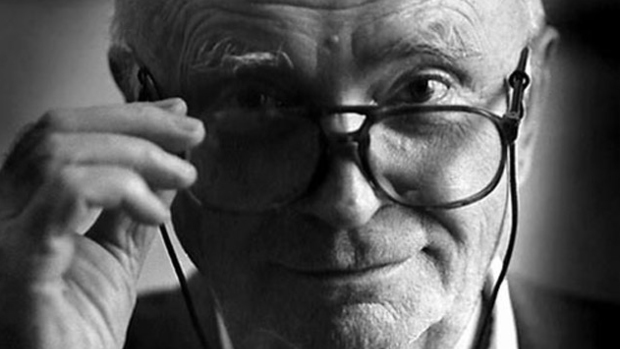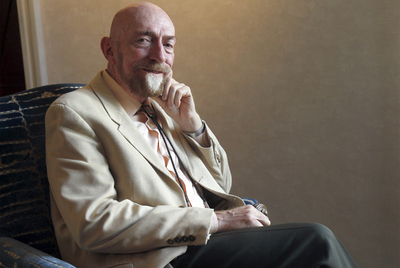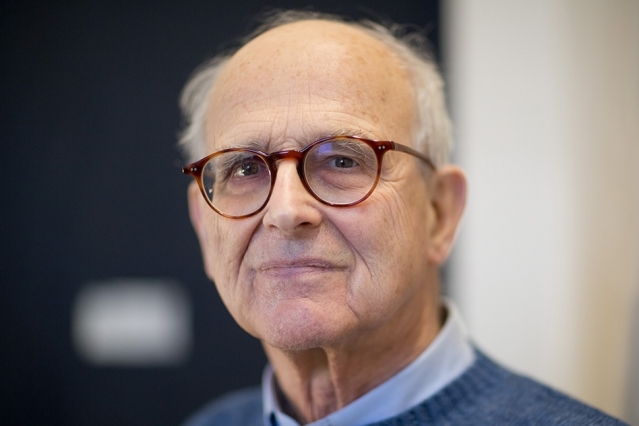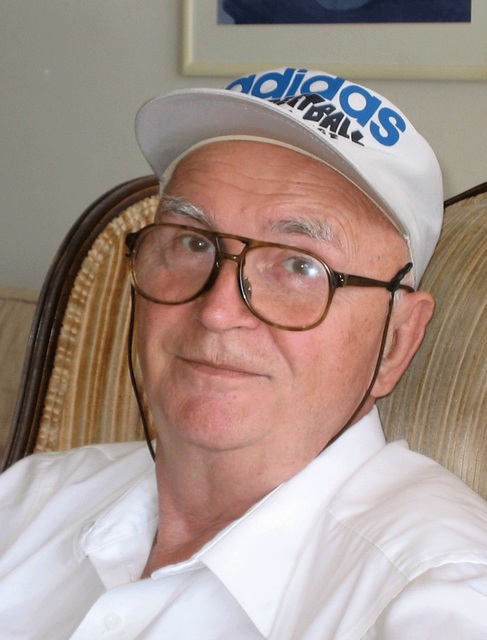
Vladimir Borisovich Braginsky. 1931 - 2016. Photo copyright Uspekhi Fizicheskikh Nauk. Used with permission.
LIGO Mourns the Loss of Vladimir Braginsky
Feature Story • April 25, 2016
Vladimir Borisovich Braginsky 1931 - 2016
Reminiscences by Kip Thorne
Vladimir Braginsky was one of the great experimental physicists of the second half of the twentieth century, and an outstanding theorist in the experimental domains where he worked. I was introduced to him in 1968 by theoretical astrophysicist Yakov Borisovich Zel’dovich. Zel’dovich described Braginsky with words of praise as high as I ever heard Zel’dovich give to anyone except Andrei Dmitrievich Sakharov, and I soon came to value him similarly.
Braginsky completed his Kandidat (PhD) in physics at Moscow University in 1959 and was immediately appointed to the University’s Physics Faculty, rising to full professor in 1968. During the 1960s he built a small but outstanding research group around himself, which he sustained and renewed over the decades from then until recently. From the outset, his primary focus was on high-precision measurements, and one key to his success was his deep understanding of the physical processes that limit such measurements, particularly thermal noise and quantum noise.
In addition to gravitational wave research, Braginsky and his group are especially well known for establishing the first strong experimental limit on the existence of free quarks (10-20 free quarks per nucleon, in 1968); their limit on the fractional difference between inertial and passive gravitational mass (10-12, in 1971, a limit that was only improved on three decades later); their pioneering development of optical micro resonators (in the 1980s and 1990s—tiny spheres excited with whispering-gallery-mode light) which have become major elements in optical technology; and their pioneering work, both theoretical and experimental, on (“naive”) quantum limits to experimental precision and ways to circumvent those limits (1967 to today)—work that has profoundly impacted not only LIGO but also optical physics and nanotechnology.
In 1962, motivated in part by Joseph Weber’s ideas, Braginsky initiated theoretical and experimental work aimed at detecting gravitational waves. His 1965 review article “Gravitational Radiation and the Prospect of its Experimental Discovery” (Soviet Physics Uspekhi 8, 513) was an early milestone, covering future prospects broadly.
In 1968, on my first visit to Braginsky’s lab, he showed me small-scale exploratory experiments aimed at scoping out the prospects not only for Weber-type resonant-bar gravitational wave detectors, but also for LIGO-like detectors with light bouncing between free swinging mirrors, where his principal focus (if my memory is right) was on thermal noise in suspensions. When I returned to Moscow a year later (August 1969), Weber had announced evidence for the existence of gravitational waves and Braginsky was embarking on building Weber-type bar detectors to confirm Weber’s results. When I returned again in September 1971, Braginsky was deploying two aluminum bars at sites 20 km apart. In August 1972, he announced his results, a non-confirmation of Weber: no coincident excitations between his two bars at a level where Weber was seeing coincidences. Confident in his non-confirmation, in 1973 (while experimenters in the West were just beginning to get results with their own aluminum bar detectors), Braginsky shut down his detectors and embarked on R&D for next generation bars, made of monocrystal sapphire.
By then Braginsky and I had become close friends and were beginning to collaborate on research. Our first joint paper was one in 1976, pointing out that the mergers of super-massive binary black holes in galactic nuclei were promising sources for space-based gravitational wave detectors; our subsequent joint papers were closer to experiment. From my collaborations with him, I gained insights into high-precision experiments that were crucial for my subsequent work on LIGO. Indeed, I regard him as one of my three principal mentors in physics, along with Zel’dovich and John Wheeler.
It was primarily through my interactions with Braginsky and with Rai Weiss, in the early and mid-1970s, that I became convinced gravitational-wave detection would ultimately succeed, which led me to trigger the creation of an experimental gravitational wave group at Caltech, led by Ron Drever and Stan Whitcomb.
From the 1970s through mid-1980s Braginsky recognized the enormous potential of the interferometric detectors that Rai pioneered and that were being developed at MIT, Garching, Glasgow, and Caltech. But Braginsky was worried that, to detect waves from astrophysical sources, the interferometers would have to become so complex that robust operation would be impossible; so he and his group continued their work on sapphire bars. In the late 1980s, however, during visits to Caltech and MIT, he saw remarkable progress on the interferometer prototypes and on plans for the 4 km LIGO detectors, and concluded that ultimate success was likely. And so, he went home, shut down his group’s bar-detector program, and refocused his group’s efforts on contributing to LIGO in whatever ways it could. This was nearly a decade before Barry Barish created the LSC, expanding LIGO beyond Caltech and MIT.
Braginsky became LIGO’s most powerful, friendly critic — in some sense LIGO’s “conscience”: Through the 1990s and 2000s he searched hard for what he called “underwater rocks” that had been missed; obstacles that would need to be dealt with, in order for LIGO to succeed. These included, among others, a series of previously unknown or under-appreciated forms of thermal noise, and perhaps most serious of all, the parametric instability that arises at high arm-cavity circulating powers; and also, of course, the quantum noise about which he had been warning since 1967, and which became a central focus of collaborative work between my group (now led by Yanbei Chen) and Braginsky’s group. In parallel, on the experimental side, Braginsky’s group developed the technology for fused-silica-fiber suspensions, now implemented in advanced LIGO, and transferred it West to the Glasgow LSC group; and Braginsky’s group also scoped out LIGO’s “excess” noise — non-Gaussian, mechanical noise (sudden jerks) — that shows up in the time domain but not the frequency domain.
Braginsky’s Moscow group was so important to LIGO that, in 1991, when the Soviet Union crumbled and funding for science in Russia dried up, Robbie Vogt, then LIGO director, provided private Caltech funds to hold his group together for a year or so until the Soros Foundation was in a position to take over the funding, and then NSF, via a subcontract to a Caltech grant led by Stan Whitcomb. If Braginsky’s group had crumbled like much of the rest of Soviet science, the consequences for LIGO could have been very bad — or so it appears to me in retrospect, when I contemplate his group’s contributions in the 1990s and 2000s.
Braginsky was a member of the Communist Party, motivated by a sense of idealistic civic responsibility; a desire to make society better. He even served as a citizen judge in the Soviet judicial system for some months. But he never marched to the party’s drum; he was more like an activist in the US Democratic Party, fighting rigid entrenched forces, to the extent that one could do so without getting thrown out.
In 1972, at the general assembly of the Copenhagen international GRG meeting, where the International Society for General Relativity and Gravitation was being created, there were several fiery anti-Soviet speeches by American physicists (triggered by Soviet visa impediments that had prevented Israeli relativists from attending the previous GRG meeting in Soviet Georgia). These impassioned speeches drove the entire Soviet delegation and most members of the other Eastern European delegations to walk out of the meeting, and threatened to derail Eastern participation in the new Society. I followed Braginsky out of the meeting and huddled privately with him, trying to figure out what to do. Bravely, Braginsky returned to the meeting, made a conciliatory speech, and participated in the organizational discussions — the only Russian to do so. He paid a price, however. Upon his return to Moscow, he was denounced for his actions and ended up on a travel blacklist for a while.
During the 1970s and 1980s, whenever Braginsky visited Caltech, an FBI agent named Mr. Bevins came to Caltech to check up on whether he had arrived and what his itinerary was. On one occasion, perhaps the third or fourth of these checkups, Mr. Bevins arrived, saw me in the hallway, and asked if he could come into my office to discuss Braginsky. I invited him in, knowing Braginsky was there, and introduced them: “Valodya — this is Mr. Bevins from the FBI here to check on you; Mr. Bevins — this is Professor Braginsky; I suggest you talk directly to each other”. There was dead silence for about a half a minute; both were in shock. Finally Mr. Bevins lifted one leg of his pants and said, “See, I’m made of flesh and bone just like you”, and there followed an extremely strained conversation. I challenged Braginsky to do the same thing with the KGB (Soviet Secret Police) who debriefed him whenever I visited him in Moscow. He never did. There was, of course, a huge difference between the KGB and the FBI.
Braginsky was one of my closest personal friends. From his descriptions of life as a teen and preteen in World War II, and then of life in the Soviet system under Stalin and Beria, and then what I saw of his life in the post-Stalin era, I learned much about ethics under extreme circumstances, and about the importance of friendship and loyalty to one’s friends. His marvelous sense of humor, in both fair weather and adversity, buoyed me. At times of despair over LIGO’s tribulations, he was a source of comfort and encouragement.
Braginsky was very ill these past several years. I flew to Moscow last May primarily to meet with him, but he was too ill even to see me. However, in February, when his son Oleg showed him LIGO’s GW150914 discovery paper with his name on it, he was well enough to understand that our quest had succeeded, at last, thanks to our superb LIGO colleagues.
His death is a terrible loss for me, personally, and for science broadly.
Reminiscences of Vladimir Braginsky
by Rainer Weiss
Vladimir was a consummate physicist. He had a marvelous intuition, he knew an amazing set of facts about our physical world and he could model and calculate bringing the understanding of a problem to its essentials. I place him in the same group with Edward Purcell, Enrico Fermi, Isidor Rabi, and Robert Dicke. We were indeed lucky to have him interested in the field of gravitational wave research.
He was one of the first to understand fully the power of the fluctuation-dissipation theorem of statistical mechanics applied to precision measurements. A beautiful demonstration of his understanding came in his version of the so called Eotvos Experiment which established the equivalence of inertial and passive gravitational mass. By being exceptionally careful with understanding the sources of dissipation in that experiment, he was able to perform a terrestrial measurement at the level of equivalence to a part in 1012, a factor of about 10 smaller than results achieved by Robert Dicke when he ran the experiment.
Early on he established that fussy macroscopic precision experiments such as gravitational wave detection would have to deal with limits imposed by quantum mechanics. He also realized that by being clever in knowing specifically the question one wanted to answer from a system, it would be possible to evade the naïve (thoughtless) quantum limits. He saw clearly that the quantum limit would come from the back action of the measurement system and began a program to design sensors which could measure a useful set of parameters of a system and still minimize the backaction. The current effort to reduce the effect of vacuum fluctuations on the measurement of the gravitational wave strain in the interferometers has benefited by his pioneering work to evade the naïve quantum limit.
Over the years of his association with LIGO, he played an important role in continually thinking about physical effects that might compromise our sensitivity which we had missed in the design of the interferometers. About a decade ago, he and his group made a critical analysis of the phase noise that comes from fluctuations of the mirror surfaces and coatings from a host of effects some we knew about but others which were new to us. The analysis included the noise from thermo-elasticity – thermally induced fluctuations of the coating thicknesses, straightforward thermal noise due to sound waves running on the surface of the mirror and coating – Brownian motion - and up to then not fully modeled refractive index fluctuations due to thermal fluctuations from both room radiation as well as from fluctuations of the intensity of the laser light hitting the mirror. The ultimate performance of the advanced LIGO detector is now limited at the most sensitive frequency by thermal noise in the mirror coatings – one of Vladimir’s deepest worries.
Another significant effect Vladimir and his group predicted would eventually become something we had to tend to is now broadly called parametric optic-acoustic instability. An effect that would become important as we increase the power in the optical cavities. The idea is that acoustic modes of the mirrors could be driven by the radiation pressure fluctuations associated with intensity fluctuations of the light in the cavity. The critical coupling occurring for those optical modes in the cavity that have a spatial overlap with the acoustic modes in the mirror and which have spectral energy at the acoustic mode frequencies of the mirrors. Early on in the commissioning of Advanced LIGO we found these instabilities and were able to control them with slight shifts in the optical mode frequencies by heating the mirrors to change their radii of curvature. As we increase the power we hope to reduce the Q of the acoustic modes by using the electrostatic feedback system on the mirrors. Even so Vladimir’s intuition and calculations may yet cause us to take even more drastic steps to avoid the instabilities.
Vladimir was an interesting person to be with. One of the moments I won’t easily forget is when he came to Cambridge to visit our lab in the late 1980s. I went to Logan airport to pick him up in my car. The tunnel between the airport and Boston was jammed and I decided to take a long cut through the cities of Chelsea and Everett which constitute an industrial wasteland outside of Boston with fuel oil storage tanks, mountains of salt, junked car lots and a major power station abutting onto slum housing on poorly maintained streets. As we entered Cambridge, Vladimir patted my hand in commiseration and said, “We have places like this as well but in America, with such great wealth, one would think there is better city planning and care for the poor and their environment.” I could not answer him.
Another memory of Vladimir I carry are his comments to me after a particularly difficult meeting with a review committee of vacuum experts who were advising the NSF on our strategy to construct the 4km beam tubes and their enclosures. The experts from vacuum groups associated with accelerator laboratories were skeptical of our design to process the metals to reduce out-gassing and thereby greatly reduce the number of pumps required to meet our goals. They were convinced that the ratio of pumping capacity to surface area was so low as to jeopardize the project and were convinced the LIGO vacuum would fail to achieve its design even though we had demonstrated the strategy in two separate experiments on different scales. I knew that if we were to build LIGO based on their recommendations, it would have significantly exceeded our estimated costs and I felt would have killed the project. Vladimir caught me sitting in a room on a corridor near the Caltech Physics Division headquarters with what must have been a pretty desperate look. He came and patted me on the back and said, “You know what you are doing is analogous to a man trying to love a woman in broad daylight in the middle of Red Square. You will get a lot of advice.” We both laughed, it was just the change in perspective that was needed.
I will miss Vladimir as a dear friend and as person who always gave good advice.







